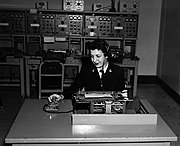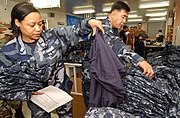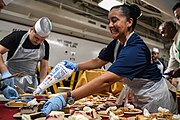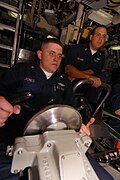Yeoman (United States Navy)
| Yeoman | |
|---|---|
 Rating insignia | |
| Issued by | United States Navy |
| Type | Enlisted rating |
| Abbreviation | YN / YNS (Submarine) |
| Specialty | Administration |
The yeoman rate is one of the oldest rates in the U.S. Navy, dating back to 1794. Historically, the Navy yeomen were responsible for keeping the storerooms for the ship's gunners, carpenters and boatswains. With the transition from sail to steam, yeomen were assigned to the ship's engineers. In the modern Navy, a yeoman is an enlisted service member who performs administrative and clerical work.
History
The
War of 1812
Civil War Era
- Thomas Atkinson, Yeoman
- William Wright, Yeoman
Spanish–American War Era
Gallery
World War I Era
With the
Yeoman School
The Yeoman School, one of the Navy's Trade Schools, had two locations: Newport in Rhode Island, and San Francisco in California. To enter Yeoman School, the recruit was required to have some prior clerical experience, be able to write legibly, and type a 200-word letter with a passing grade of 70% or better. Knowledge of stenography was desirable, but not required. "Steno" classes would be available after hours.[7]: 27




Preliminary classes, lasting between 4–6 weeks, would cover arithmetic, spelling, composition, and general naval knowledge. The final examination would determine eligibility for the next level of classes.[7]: 28 Supply-officer department classes covered preparation of requisitions, surveys, public bills, official returns, and supply-related duties. General bookkeeping, inventories, mess statements, and balance sheets were also taught. Executive-officer department classes covered record-keeping for enlisted men. Correct preparation of forms for arrival/departure of men; ratings and disratings; appointments; and discharges, desertions, and death were covered. Pay-officer department classes required a thorough knowledge of arithmetic. Making up payrolls, computing pay for officers and enlisted men (including allowances, bounties, and extra pay), calculating credit and interest on payroll savings accounts, and preparing payroll checks were some of the duties covered in these classes. Commanding-officer department classes covered the production of various forms of official correspondence, such as official letters, and endorsements. The yeoman had to be familiar with the channels through which the documents would pass, as well as the approved filing systems for storing the paperwork. Generating the proceedings for courts-martial and other courts of inquiry or inquests was also covered. The use and proper care of a typewriter was extremely important in the preparation of these documents. Each of the above classes was 5 weeks long.[7]: 29
Upon entering Yeoman School, the recruit's ranking was landsman-for-yeoman, with a monthly salary of $17.60. Good grades and good conduct could be rewarded with a promotion to landsman-for-yeoman, second class, and a monthly salary of $20.90. Upon graduation, the ranking would be either yeoman, third class (Y3C), at $33.00 per month or yeoman, second class (Y2C), at $38.00 per month. The new yeomen would be granted 10 days leave, with additional time allowed for travel, before transferring to his next station. [7]: 29
Yeoman (F)

The
Sinking of USS President Lincoln

President Lincoln left Brest, France on 29 May 1918 with 715 persons aboard, including crew, wounded US Army soldiers and other passengers aboard. She sailed in convoy with 3 other transport ships. The convoy escorts left the westbound ships on the evening of 30 May to meet up with an east-bound convoy. The westbound convoy was considered to be safe from German submarines during the night. However, the U-90 had spotted the convoy earlier that afternoon and raced ahead. U-90 attacked the convoy about 9 am on 31 May. Struck by three torpedoes, she sank about 30 minutes later. Three officers and twenty-three enlisted men were killed. None of the Army wounded or other passengers were lost. They were rescued later that day by three destroyers dispatched by the escort commander.[9]
One of the sailors who perished was Yeoman 2nd Class Frederick W. Wilson.[10] American Legion Post 62 of Denison, Texas, was named in Wilson's honor. His father, Frederick W. Wilson, Sr, was a Denison resident.[11]
Agnes Meyer Driscoll
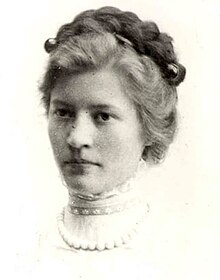
Agnes Meyer Driscoll graduated from Ohio State University in 1911 with a bachelor's degree in mathematics and physics. She was also proficient in four foreign languages: French, Latin, German, and Japanese. Driscoll enlisted with the US Navy as a chief yeoman (F) in 1918, and worked in the Code and Signal Section of the Director of Naval Communications. throughout WWI. After the war ended, she continued working for the US Navy as a civilian crypto-analyst. She was instrumental in breaking the Red Book Japanese naval cipher in the mid-1920s, and the Blue Book Japanese naval cipher in 1930.[12][13]


About the same time (early 1930s),

Over on the West Coast of the mainland US, Harry J. Thompson was a former US Navy yeoman, and now jobless. In 1934, Thompson had been recruited by Lt Cmdr Toshio Miyazaki of the Imperial Japanese Navy. Miyazaki was posing as Mr. Tanni, an English language exchange student at Stanford University. Thompson was given the uniform of a chief yeoman and was able to access classified information on gunnery and gunnery tactics.[15] While drunk, Thompson confided to his roommate, Willard James Turrentine, also unemployed, about the spy ring. Turrentine informed the ONI, passing along some of Thompson's correspondence as proof. The Federal Bureau of Investigation (FBI) placed Thompson under surveillance, and arrested him in March 1936 under the Espionage Act of 1917. Thompson was convicted, and sentenced to 15 years at McNeil Island Federal Penitentiary. On the day Thompson was arrested, Miyazaki fled back to Japan.[14]
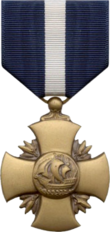
The Navy Cross award for valor was established by the US Congress on 4 February 1919 to honor sailors and marines who displayed extraordinary heroism in combat with an armed enemy force. The Act was made retroactive to 6 April 1917. The following yeomen received this award:[16][17]
- Chief Yeoman Harry B. Alderman
- USS Cleveland, February 16, 1918
- Citation: "The Navy Cross is awarded to Chief Yeoman Harry B. Alderman, U.S. Navy (Reserve Forces), for extraordinary heroism and devotion to duty on the occasion of a fire on the U.S.S. Cleveland at sea, on February 16, 1918. Chief Yeoman Alderman, with others, descended into a compartment over the after-magazine, filled with smoke and suffocating fumes, and successfully extinguished the fire after forty-five minutes' work."[18]
- Yeoman 2nd Class Roger Johnstone
- no information available[17]
- Yeoman 1st Class Matthew E. O'Gorman
- Gunner/Observer, Northern Bombing Groups, June–November, 1918
- Citation: "The Navy Cross is awarded to Yeoman First Class Matthew E. O'Gorman, U.S. Navy (Reserve Forces), for distinguished and heroic services as a gunner and observer of airplanes of the Northern Bombing Groups in France, co-operating with the Allied Armies on the Belgian Front, from June to November, 1918, in bombing raids over enemy territory and in action against enemy aircraft."[19]
- Chief Yeoman Ralph W. Shuey
- USS Cassin, October 15, 1917
- Citation: "The Navy Cross is awarded to Chief Yeoman Ralph Waldo E. Shuey, U.S. Navy, for extraordinary heroism and devotion to duty on the occasion of the torpedoing of and explosion on the U.S.S. Cassin on October 15, 1917. Chief Yeoman Shuey, with other members of the crew, was untiring in his work of shoring up bulkheads, restaying masts, and improvising means of towing. He set an example to the younger and less experienced members of the crew."[20]
- Chief Yeoman Emerson B. Wentworth
- USS Mount Vernon, September 5, 1918
- Citation: "The Navy Cross is awarded to Chief Yeoman Emerson B. Wentworth, U.S. Navy, for distinguished service and devotion to duty while serving on the U.S.S. Mount Vernon, when that vessel was torpedoed September 5, 1918. Chief Yeoman Wentworth went to his station at the forward fire control to assume charge, and was on the ladder leading to it, when the ship was struck. By admonitions and physical exertions he forced men back to their stations and duties, materially aiding the proper operation of the fire control and displaying high qualities of leadership."[20]
World War II era
The duties of the navy yeomen aboard a battleship during World War II are remembered by the living historians of the USS North Carolina, now a museum ship in Wilmington, North Carolina. There were ten yeomen of the executive division of the executive department. The executive department was responsible for all duties on the ship except for those performed by the gunnery and navigation departments. It contained divisions responsible for supply, medical, engineering, security, and the executive functions aboard ship. The yeoman staff included: Chief yeoman (also known as the ship's writer), one yeoman 1st class, three yeoman 2nd class, two yeoman 3rd class, and three seamen who were learning on the job to become yeomen (known as "strikers").[21]

North Carolina was a combat vessel. Therefore, besides the traditional duties of a yeoman "
- Secondary battle plot (battle recorder)
- Auxiliary CIC (3JW phone circuit talker)
- Turret 2 booth (phone talker)
- Damage control station (X1JV phone circuit talker)
- Repair 1 (forward) (fire party & traffic control, valveman)
- Repair 2 (aft) (fire party)
- Repair 3 (chief in charge, fire party, valveman & fire party)
- Conning tower (3J2 phone circuit talker, JA phone circuit talker)
- Battle II (JA phone circuit talker, JL phone circuit talker)
- Central station and forward gyro (JA phone circuit talker)
Note that duties of battle recorder and the various circuit talkers (who relayed orders over the shipboard telephone system) required the attention to detail that was part of the yeoman training. That a yeoman was in charge of the repair parties made use of his organizational skills.
Another aspect of the yeoman's duties was highlighted during the
Indiana University Bloomington
- Now we have a job to do. Each citizen has a job: each state has its job, and we on the campus of Indiana University have a job. Our first task must be to keep a clear, level head in the midst of intellectual hysteria that can so easily sweep the country. A university campus is the first place that this objective thinking should be prominent in the settlement of the many problems that now confront us ... We do not want to act in a way that our opportunities to aid mankind in the future will be jeopardized. We must continue to plan for the things that lie beyond this chaotic valley that the world is in now. We are fighting for freedom and democracy now and we want to be prepared to administer it when the war is over.[24]
Between 7–14 January 1942, a committee of administrators, professors, and one student outlined a plan of change to put IUB on a war footing to support the war effort. They adopted a three-semester academic plan to condense a 4-year program into two years and nine months. They also established an organization, the "Junior Division", to help high school graduates make the university transition more easily.[25]
The Naval Training Station at IUB was first considered in 1940, when administrators saw the success of the NROTC (Naval Reserve Officer Training Corps) program at Northwestern University. The US Navy saw the School of Business at IUB as perfect for a Yeoman School.[23] Incorporating NROTC into the university's curriculum meant including Naval V-1 training, a US Naval Reserve Accredited College Program and Naval ROTC.[26] In July 1942, the first class of yeoman recruits arrived for four months of training. Naval instruction occupied 35 classrooms, with 5–6 hours of intense training per day. Course subjects included: general storekeeping, disbursement, provisions, clothing and small stores, aviation, typewriting, spelling, English grammar, and correspondence. By mid-July, the campus began to assume a nautical flavor. The three buildings of the Men's Residence Center, where the yeoman recruits were housed, began to be referred to as "vessels", the student rooms became "cabins", the campus became the "good ship Indiana University" or the "USS Indiana", and Bloomington was the "shore". The Navy students had their own campus newspapers, The Quill and The Yeoman.[25][27]
During the late fall of 1942, the Navy WAVES began to replace the male sailors. By January 1943, the naval student population was evenly split between men and women. In May, the last of the men were graduated, and the Navy school became exclusively women. The US Coast Guard SPARS arrived in June, followed by the USMCWR (US Marine Corps Women's Reserve). By the fall of 1943, the number of graduates began to exceed the number being assigned to stations. The Naval Training Station was closed on 30 June 1944. The "good ship Indiana University" had trained over 5000 men and women for the US Navy.[25][27]
WAVES

The US Naval Reserve (Women's Reserve), more commonly known as the WAVES (Women Accepted for Volunteer Emergency Service), was established by the US Congress on 21 July 1942. Women would be accepted into the Naval Reserve for the duration of the war, plus six months. Both commissioned officers and enlisted personnel were recruited. The enlisted WAVES performed mostly clerical and storekeeping duties onshore, allowing their male counterparts to be reassigned to sea duties. Other enlisted WAVES performed support duties such as aviation mechanists or metalsmiths, parachute riggers, control tower operators, and radio operators.(2001 Goodson) On the second anniversary of the WAVES (not long after the
- "history will record that the WAVES fulfilled a great purpose. In 500 shore establishments of the fleet, women in uniform took over the work of Navy men. They released enough of them from noncombatant duty to man all our landing craft in two important operations: the Normandy landing on June 6 and the Invasion of Saipan on June 15. The Women’s Reserve will continue to speed the victory day by efficient performance of vital duties ashore."
Iowa State Teacher's College




Located at Cedar Falls, Iowa, and now part of the
Initially, the Navy combined naval training with job training at "indoctrination schools", which proved to be a mistake. The amount of material covered in classes was massive. The Sextant, the blog of the Naval History and Heritage Command (NHHC), quoted Jacqueline Van Voris (an instrumented flying instructor for Navy pilots between 1944 and 1946) in her unpublished manuscript: "New recruits were warned that one midshipman dropped her pencil during a history lecture and while she was picking it up missed all of the naval battles of the civil war".[28] The Navy also encountered problems with having several indoctrination schools in various locations across the country, so it separated job training as dedicated courses, and consolidated WAVES basic training at Hunter College, The Bronx, New York City. In April 1943, the Yeoman School replaced the indoctrination school at ISTC. The Yeoman School remained in operation until April 1945. By that time, ISTC had graduated 14,000 WAVES.[29][30]
Some of the WAVES recruits celebrated the second anniversary of their organization by de-tasseling seed corn at Reinbeck, Iowa. The WAVES were given permission to spend their liberty hours on two weekends (29-30 July and 5–6 August 1944) as farm emergency workers. They relieved the 14- and 15-year old workers who de-tasseled during the week. Available truck transport limited the number of WAVES volunteers to about 150. A representative of a corn seed company presented a color slide program explaining the life cycle of the corn plant and why de-tasseling is important for production of high-quality seed corn. The sight of WAVES working in the corn fields attracted both the local citizenry as well as the newsreel cameramen. (2015 Krein, p 60–1)
Hunter College (Basic Training)

Beginning in February 1943, most enlisted recruits received their basic training at Hunter College, in the Bronx, New York City, which became known as "USS Hunter". The US Marine and US Coast Guard women recruits also received basic training here.(See USMCWR and #SPARS below.)[31][32] Boot camp for the WAVES recruits was a six-week program, similar in emphasis and content to the male version.(2001 Goodson) Physical fitness was stressed, with classroom instruction in Navy ranks and ratings, naval history, tradition and customs, courtesy, discipline, and the organization of the fleets.(Hancock) The first class contained 1,993 graduates. From then on, every two weeks, Hunter College would enroll another class numbering between 1,600 and 1,700 WAVES.[28] By the end of WWII, about 81,000 WAVES were trained at Hunter College.[33]
An interesting episode centered around the mess hall at Hunter College according to Van Voris as quoted in The Sextant. The cafeteria staff prepared and served about 15,000 meals every day for the WAVES. At the male boot camps, the recruits were allotted 23 minutes, while the female recruits tended to take a bit longer. Furthermore, while the men would grumble about the chow, the women immediately and loudly complained about the menu. As the number of WAVE recruits assigned to galley duty increased, the quality of the food also increased. By August 1943, a school for cooks and bakers was established. After that, Hunter College became known for its good food, strong coffee, and fresh baked bread.[28]
Georgia State College for Women

Georgia State College for Women, in Milledgeville, Georgia (now part of Georgia College & State University) was the location of the Naval Training School (Storekeepers - W). The school was opened in 1943, and over 15,000 WAVES attended by the war's end. Most graduates were assigned to stations within the continental US, until an act of Congress permitted WAVES to serve in Alaska and Hawaii, which were US territories at the time.[34][35] In a 2019 interview with the Union-Recorder of Milledgeville, Georgia College historian Robert Wilson recalled how the WAVES students, marching in formation through the campus and small town from sunup to sundown, disturbed the tranquility of the formerly genteel upper-class southern women's college. The WAVES were housed separately from the main student body (known as "Jessies"). The 1945 yearbook staff, on its introductory page to the military students, wrote:
- "Some in our midst are dressed in Navy blue. They are just like the rest of us, only farther away from home, and sometimes more homesick, even though they proudly wear one of Uncle Sam’s uniforms. Long after they’re gone we’ll still remember their cheerful singing as they march through the rain, the little short girl on the end of the platoon running to keep up, those jaunty salutes, their frequent and impressive graduations, and the smiling ‘Hi’ in reply to our ‘Hey.’"[35]
Wilson also recalled another time in May 1943, when
- Yeoman 2nd Class Charles B. Fletcher
- LCI(L)-5, Sicily
- Citation: "The President of the United States takes pleasure in presenting the Navy Cross to Charles Binford Fletcher, Yeoman Second Class, U.S. Navy (Reserve), for extraordinary heroism and devotion to duty in action against the enemy while serving aboard Infantry Landing Craft U.S.S. LCI(L), FIVE (LCI(L)-5), during the amphibious assault on the Island of Sicily on 10 July 1943. Determining the depth over sand bars by swimming toward the beach within hazardous range of hostile guns ashore, Yeoman Second Class Fletcher located a suitable beaching point for disembarking our attack troops. Upon completing this dangerous task and observing several soldiers perilously close to drowning, he risked his life under an unrelenting shower of deadly machine-gun bullets to swim through extremely heavy surf and bring the helpless men to safety. Through his courageous efforts and heroic endurance in the face of withering fire, he was able to accomplish the successful rescue of the soldiers who otherwise might have perished. Yeoman Second Class Fletcher's exceptional courage and valiant devotion to duty in the face of grave danger were in keeping with the highest traditions of the United States Naval Service."[36]
- Chief Yeoman Benjamin Sachs (Missing in Action)
- USS Liscome Bay (CVE-56), Gilbert Islands
- Citation: "The President of the United States takes pride in presenting the Navy Cross (Posthumously) to Benjamin Sachs, Chief Yeoman, U.S. Navy, for extraordinary heroism and devotion to duty while serving on board the Escort Carrier U.S.S. LISCOME BAY (CVE-56), in action against the enemy when that vessel was sunk near Makin Island in the Gilbert Islands on 24 November 1943. When the U.S.S. LISCOME BAY was struck by a torpedo, Chief Yeoman Sachs observed an officer lying prone on the deck and partially covered with debris. Disregarding his own safety, he removed the debris, revived his shipmate and led the way through the only possible escape route. Then he fastened a life preserver to the officer's body and assisted him over the side. The conduct of Chief Yeoman Sachs throughout this action reflects great credit upon himself, and was in keeping with the highest traditions of the United States Naval Service. He gallantly gave his life for his country."[37]
- Yeoman 1st Class James L. Snyder
- USS Nevada (BB-36), Pearl Harbor, Hawaii
- Citation: "The President of the United States takes pleasure in presenting the Navy Cross to James L. Snyder, Yeoman First Class, U.S. Navy, for exceptional courage, presence of mind, and devotion to duty and disregard for his personal safety while serving on board the Battleship U.S.S. NEVADA (BB-36), during the Japanese attack on the United States Pacific Fleet in Pearl Harbor, Territory of Hawaii, on 7 December 1941. As phone-talker on the navigation bridge of the U.S.S. NEVADA (BB-36), Yeoman First Class Snyder remained on the navigation bridge until forced by fire to leap to safety to the bridge below. Thence he went to an antiaircraft gun ammunition ready box and despite the fact that the heat was exploding other similar boxes, he removed all the ammunition thereby saving lives and assuring continuance of the gun's operation. The conduct of Yeoman First Class Snyder throughout this action reflects great credit upon himself, and was in keeping with the highest traditions of the United States Naval Service."[37]
Gallery
-
Yeoman typing class, San Diego Naval Training Center, CA, 1934.
-
VADM William F. Halsey with members of his staff, c. 1941-42. His yeomen are at the far right: (from right to left) Yeoman I.N. Bowman; CY H.C. Carroll; and CY P.T. Hunt.
-
Y3c C. S. Foley (left) taking dictation from LCDR William P. Mack, NAS Adak, AK, 1943.
-
CY Cook (left) and LCDR Knapper of USS Texas (BB-35) inspecting bombardment damage, Pointe du Hoc, France, 1944.
-
Ship's yeomen of escort carrier USS Makin Island (CVE-93), c. 1945.
-
WAVE Y3c Ruth Beffre on duty at Navy Headquarters, New York City, 1943. Note candlestick phone, forms, and paper trays on desk.
-
WAVE yeoman transcribing dictation from a dictation machine. Note yeoman's headphones and the dictation machine on the desk.
-
WAVES microfilming vouchers, Washington D.C., February 1945
-
WAVE Y3c Harriette Heyman operating a ditto machine, 1943
-
WAVE yeoman storekeepers load oil cans on a pallet, c. 1944
-
WAVE Y3c Betty Dickinson, with barracks mascot "Okinawa", assigned to Pearl Harbor, May 1945
Korean War
According to the US Department of Defense, (ValorPortal Korea) no yeomen were awarded the Navy Cross during the Korean War.
Gallery
Cold War
Vietnam War
According to the US Department of Defense,(ValorPortal Vietnam) one yeoman was awarded the Navy Cross during the Vietnam War.
- Gary G Gallagher Y3c
Capture of USS Pueblo by North Korea
Gallery
Rate and rating
The US Navy has a hierarchy that is unique among the US armed forces. "Rank" is reserved for naval officers and warrant officers. "Rate" and "rating" is applied to enlisted personnel. "Rate" refers to a seaman's pay grade; "rating" refers to the occupational specialty. The approximate naval equivalent of the US Army infantry sergeant would be a boatswain's mate second class.[3] Following is a brief listing of the various yeoman rates and ratings between 1797 and 1896:[1]
- Yeoman of the gunroom (1797-1813)
- Captain's clerk (1798)
- => changed to yeoman (1835)
- => changed to ship's yeoman (1884)
- => changed to yeoman (1893)
- Carpenter's yeoman (1798)
- Gunner's yeoman (1798-1838)
- Boatswain's yeoman (1799-1864)
- Paymaster's steward (1861)
- => changed to paymaster's writer (1867)
- => changed to paymaster's yeoman 1c, 2c, 3c (1870)
- => discontinued 1893
- Engineer's yeoman (1874-1893)
- Equipment yeoman (1884-1893)
- Ship's writer (1865)
- => changed to writer 1c (1893)
- => changed to yeoman 1c (1896)
- Writer 2c and 3c (1893)
- => changed to yeoman 2c and 3c (1896)
Note that this list illustrates the gradual shift towards administrative and clerical duties between 1800 and 1900, tasks which are familiar to modern US Navy yeomen.[38]

Today's yeomen performs
Training
Yeoman Class 'A' School, approximately 7 weeks long, is held at the Naval Technical Training Center (NTTC), located on the Naval Air Station Meridian in Mississippi. Yeomen in the submarine service (YNS) then attend 4 weeks of submarine instruction at the Naval Submarine Base New London in Connecticut. Yeoman Class 'C' school, for flag officer writer (NEC A15A), is also at NTTC Meridian, and is run as a five-week course.[38]
Flag writer

A yeoman flag writer is a senior yeoman, typically at the petty officer first class (E-6) level or higher, who serves on the personal staffs of flag and/or general officers and certain other senior officers. Flag writers draft personal and professional correspondence, act on matters of social usage, protocol, honors and ceremonies, prepare and liquidate travel orders, and prepare officer reports of fitness for signature by a flag or general officer. They must be able to function independently. Individuals serving as flag writers are in a highly visible position and must conduct themselves in a professional manner at all times. Additionally, members will be required to satisfactorily meet any additional requirements of the flag officer.[39]
Rate structure
- Yeoman Seaman Recruit / YNSR (E-1)
- Yeoman Seaman Apprentice / YNSA (E-2)
- Yeoman Seaman / YNSN (E-3) (See USN apprenticeships)
- Yeoman Third Class / YN3 (E-4)
- Yeoman Second Class / YN2 (E-5)
- Yeoman First Class / YN1 (E-6)
- Chief Yeoman / YNC (E-7)
- Senior Chief Yeoman / YNCS (E-8)
- Master Chief Yeoman / YNCM (E-9)[40][41]
Gallery
-
YN2 Thomas Jones demonstrates life preserver inflation during "abandon ship" drill aboard USS Makin Island (LHD-8).
-
YN1 Latricia Perkins (left), assigned to the Administration Department at Naval Air Facility Atsugi, Japan, sorts through a pile of the new Navy Working Uniforms.
-
YN2 Nelson Munoz mans Damage Control Console during "general quarters" drill aboard USS Shiloh (CG-67).
-
YN2 Tasha McAllister reviews muster roll during "general quarters" drill aboard USS Harry S Truman (CVN-75).
-
YN2 Patrick Shuman mans his station as deck control phone talker during a replenishment at sea (RAS) between Military Sealift Command (MSC) USNS Bridge (T-AOE-10) and USS Nimitz (CVN-68).
-
YNC Inez Cannon adds the topping to Thanksgiving dinner pie aboard USS Theodore Roosevelt (CVN-71).
-
YN3 Tanya Enis stands force protection watch inPusan harbor as USS Blue Ridge(LCC-19) makes a 2-day port call.
-
YN3 Joshua Jones, helmsman of the watch, maintains course and depth of USS Henry M. Jackson (SSBN-730). Diving officer of the watch Chief Fire Control Technician Troy Leonard looks on.
-
YNSN Jessica Gardner and YNSN Whitney Utter salute as USS Kitty Hawk (CV-63) passes over final resting spot of USS Lexington (CV-2).
-
Aboard thePapua, New Guinea. USNS Mercy had just completed tsunami and earthquake relief operations in Indonesia (2005).
U.S. Marine Corps
The position of yeoman in the U.S. Marine Corps Reserve was first assigned to women marines during World War II.
U.S. Coast Guard
Although the U.S. Coast Guard is a separate arm of the U.S. military during peacetime, it becomes a part of the U.S. Navy under wartime conditions. Therefore, a short history of Coast Guard yeomen is appropriate here.
U.S. Revenue Cutter Service
Modern U.S. Coast Guard
SPARS
References
- ^ a b c Malin, Charles A. (December 1969). "Compilation of Enlisted Ratings and Apprenticeships, U.S. Navy, 1775 to 1969". Naval History and Heritage Command. United States Navy. Archived from the original on 14 November 2020. Retrieved 17 December 2020.
- ^ "Chap XII. An Act to provide a Naval Armament" (PDF). Third Congress. Session I. Library of Congress. 27 March 1794. pp. 350–51. Retrieved 18 January 2021.
- ^ a b Roland, Nicholas (1 November 2019). "The History of Navy Rank (or Rate): Enlisted Personnel". The Sextant. Naval History and Heritage Command. Archived from the original on 22 October 2020. Retrieved 17 December 2020.
- ^ "Historical Surveys of the Evolution of US Navy Uniforms". Naval History and Heritage Command. United States Navy. 12 January 2017 [1954]. First Enlisted Man's Uniform. Archived from the original on 26 November 2020. Retrieved 18 January 2021.
- ^ "A Historical Overview of the Yeomen (F)". Naval History and Heritage Command. United States Navy. 2019. Archived from the original on 29 November 2020. Retrieved 18 January 2021.
- ^ a b c d "The U.S. Navy Enlistment, Instruction, Pay, and Advancement". Naval History and Heritage Command. United States Navy. 2019. Archived from the original on 17 October 2020. Retrieved 18 January 2021.
- ^ a b "The WAVES' 75th Birthday". Naval History and Heritage Command. United States Navy. 2019. Archived from the original on 17 October 2020. Retrieved 18 January 2021.
- ^ "The Sinking of the USS President Lincoln, 31 May 1918". U.S. Naval Institute Naval History Blog. U.S. Naval Institute. Archived from the original on 25 April 2020. Retrieved 18 January 2021.
- ^ "NH 103372 Frederick W. Wilson". Naval History and Heritage Command. United States Navy. 2021. Archived from the original on 1 February 2021. Retrieved 18 January 2021.
- ^ "Post 62 Denison, Texas". The American Legion. The American Legion. 2021. Archived from the original on 9 January 2020. Retrieved 18 January 2021.
- ^ "The Legacy of Women in American Cryptology: Part 2". National Security Agency Central Security Service. National Security Agency. 13 March 2020. Archived from the original on 1 December 2020. Retrieved 20 February 2021.
- ^ "Agnes Meyer Driscoll 2000 Hall of Honor Inductee". National Security Agency Central Security Service. National Security Agency. Archived from the original on 26 November 2020. Retrieved 20 February 2021.
- ^ a b Rafalko, Frank J. (ed.). "American Revolution to World War II The Search for Japanese Spies". A Conterintelligence Reader, Volume One. Federation of American Scientists. Archived from the original on 1 August 2019. Retrieved 20 February 2021.
- ^ Thompson, Harry. "Brief of the Confession of H.T. Thompson" (PDF). NCIS History Project. Naval Criminal Investigative Service. Archived from the original (PDF) on 31 August 2018. Retrieved 20 February 2021.
- ^ a b "Service Cross - World War I". Home of Heroes Medal of Honor. LEGAL HELP FOR VETERANS, PLLC. Archived from the original on 5 December 2020. Retrieved 20 February 2021.
- ^ "Navy Cross - WWI - US Navy A-C". Home of Heroes Medal of Honor. LEGAL HELP FOR VETERANS, PLLC. Archived from the original on 21 February 2021. Retrieved 20 February 2021.
- ^ "Navy Cross - WWI - US Navy M-R". Home of Heroes Medal of Honor. LEGAL HELP FOR VETERANS, PLLC. Archived from the original on 21 February 2021. Retrieved 20 February 2021.
- ^ a b "Navy Cross - WWI - US Navy S-Z". Home of Heroes Medal of Honor. LEGAL HELP FOR VETERANS, PLLC. Archived from the original on 21 February 2021. Retrieved 20 February 2021.
- ^ a b "EX DIVISION". USS North Carolina WWII Living History Crew. USS North Carolina WWII Living History Crew. 2015. Archived from the original on 7 January 2015. Retrieved 9 February 2021.
- ^ "Court of Inquiry, HQ Commander Marianas Guam, 13 August 1945 Interrogation of McVay". Naval History and Heritage Command. US Navy. 2016. Archived from the original on 28 October 2020. Retrieved 9 February 2021.
- ^ a b "OUR HISTORY". Army ROTC. Indiana University Army ROTC. Archived from the original on 8 February 2021. Retrieved 8 February 2021.
- ^ "Reactions to Pearl Harbor". Indiana University Archives Exhibits. Indiana University Bloomington. 2021. Archived from the original on 17 February 2020. Retrieved 8 February 2021.
- ^ a b c "IU During the War Years I". Indiana University Archives Exhibits. Indiana University Bloomington. 2021. Archived from the original on 17 February 2020. Retrieved 8 February 2021.
- ^ "US Navy Abbreviations of World War II: V". Naval History and Heritage Command. US Navy. 2015. Archived from the original on 30 January 2021. Retrieved 8 February 2021.
- ^ a b Eller, Nolan (7 January 2013). "United States Naval Training School and the U.S.S. Indiana University". Blogging Hoosier History Indiana University Archives. Indiana University Bloomington. Archived from the original on 15 October 2020. Retrieved 8 February 2021.
- ^ a b c d "Navigating the WAVES in World War II". The Sextant, Naval History and Heritage Command Blog. US Navy. 2014. Archived from the original on 29 November 2020. Retrieved 17 February 2021.
- ^ a b Krein, Marissa (2015). ""Our Navy" : women accepted for voluntary emergency service at Iowa State Teacher's College, 1942-1945". UNI ScholarWorks. Rod Library, University of Northern Iowa. Archived from the original on 1 August 2020. Retrieved 17 February 2021.
- ^ a b "WAVES Training Center: Cedar Falls, Iowa". Naval History and Heritage Command. US Navy. Archived from the original on 15 February 2021. Retrieved 17 February 2021.
- ^ Stremlow, USMCR (ret), Colonel Mary V. "FREE A MARINE TO FIGHT: Women Marines in World War II" (PDF). US Marine Corps. Archived from the original (PDF) on 19 January 2020. Retrieved 17 February 2021.
- ^ Stremlow, USMCR (ret), Colonel Mary V. "Early Training: Holyoke and Hunter". Marines in World War II Commemorative Series. National Park Service. Archived from the original on 20 February 2020. Retrieved 17 February 2021.
- ^ "WAVES Training Center: The Bronx, New York City". Naval History and Heritage Command. US Navy. 2016. Archived from the original on 17 February 2021. Retrieved 17 February 2021.
- ^ a b c d Dean, Catherine (16 March 2019). "For Women's History Month, a look back at the WAVES' time in Milledgeville". The Union-Recorder. unionrecorder.com. Archived from the original on 16 March 2021. Retrieved 16 March 2021.
- ^ "Navy Cross - WWII - Navy - E F". Home of Heroes Medal of Honor. LEGAL HELP FOR VETERANS, PLLC. 2020. Archived from the original on 16 March 2021. Retrieved 16 March 2021.
- ^ a b "Navy Cross - WWII - Navy - S". Home of Heroes Medal of Honor. LEGAL HELP FOR VETERANS, PLLC. 2020. Archived from the original on 16 March 2021. Retrieved 16 March 2021.
- ^ "YN Career Path" (PDF). Years of Service. United States Navy. 2019. Archived from > the original on 16 October 2020. Retrieved 1 February 2021.
- ^ "U.S. Navy: List of Ranks, Insignia, and Pay Range". FederalPay.org. 2021. Archived from the original on 11 November 2020. Retrieved 1 February 2021.
Further reading
- Mann, Michael; Parsons, Mark (2017). Parsons, Mark (ed.). MICKEY'S MINESWEEPER - One Account of a Navy Yeoman During World War Two. Port Townsend, Washington: Parsons Publishing Company. ISBN 9781549854712.
- Ebbert, Jean; Hall, Mary Beth (2014). Crossed Currents - Navy Women in a Century of Change (3rd ed.). Washington DC: Potomac Books Incorporated. ISBN 9781612347295.








